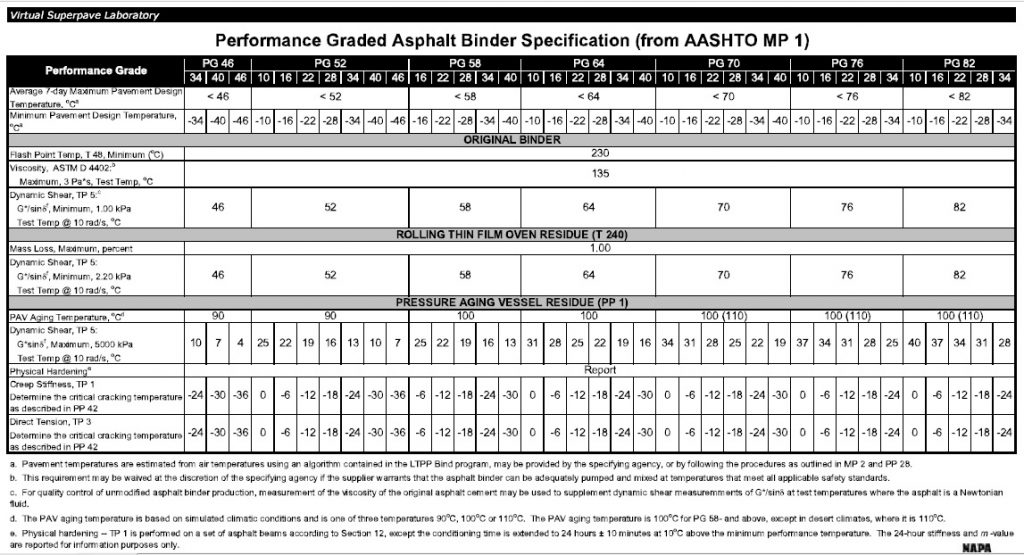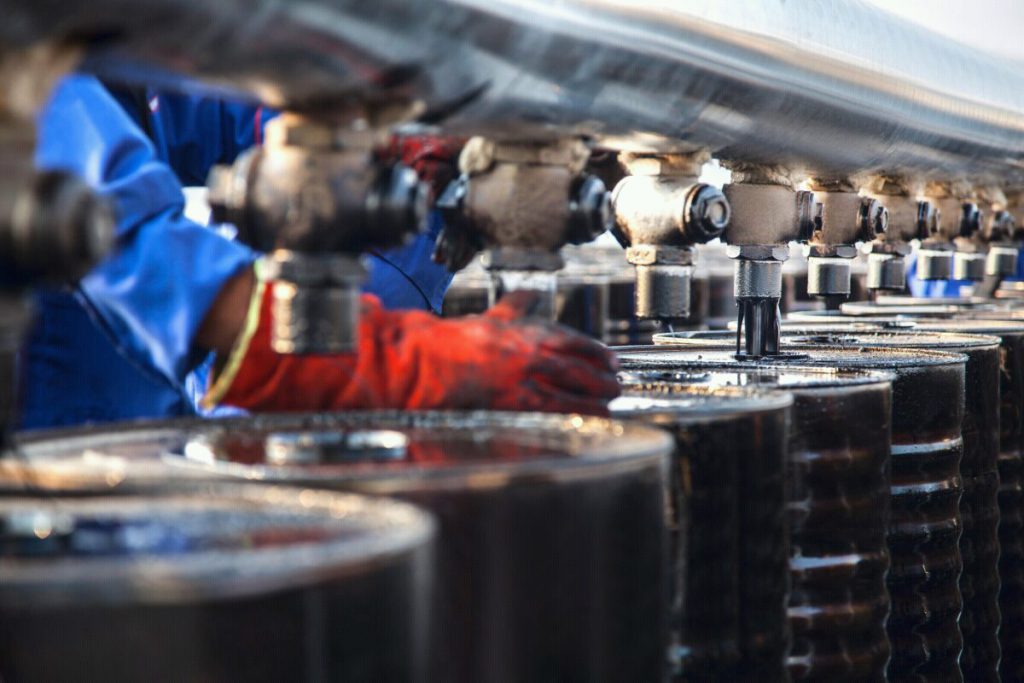
Superpave Performance Grade (PG) Bitumen
The performance grade bitumen is based on the evaluation of the material performance when in use, unlike being rational as in the viscosity grading system. The viscosity grading system is more into the experience-based method of grading. And this has proved to have excellent performance for over 20 years in US pavement construction.
The Superpave grading was developed as a part of a 5year strategic highway research planning (SHRP) from 1987 to 1992, to have a performance-based grading system for bitumen. These were developed based on the engineering features that will help in solving many of the engineering problems.
Penetration grading and viscosity grading are somewhat limited in their ability to fully characterize asphalt binders for use in HMA pavement. Therefore, as part of the Superpave research effort, new binder tests and specifications were developed to more accurately and fully characterize asphalt binders for use in HMA pavements. These tests and specifications are specifically designed to address HMA pavement performance parameters such as rutting, fatigue cracking, and thermal cracking.
Superpave performance grade bitumen is based on the idea that an HMA asphalt binder’s properties should be related to the conditions under which it is used. For asphalt binders, this involves expected climatic conditions as well as aging considerations. Therefore, the PG system uses a common battery of tests (as the older penetration and viscosity grading systems do) but specifies that a particular asphalt binder must pass these tests at specific temperatures that are dependant upon the specific climatic conditions in the area of use. Therefore, a binder used in the Sonoran Desert of California/Arizona/Mexico would have different properties than one used in the Alaskan tundra. This concept is not new – the selection of penetration or viscosity graded asphalt binders follows the same logic – but the relationships between asphalt binder properties and conditions of use are more complete and more precise with the Superpave PG system. Information on how to select a PG asphalt binder for a specific condition is contained in the Superpave mix design method. Table 1 shows how the Superpave PG system addresses specific penetration, AC, and AR grading system general limitations.
| Limitations of Penetration, AC and AR Grading Systems | Superpave Binder Testing and Specification Features that Address Prior Limitations |
| Penetration and ductility tests are empirical and not directly related to HMA pavement performance. | The physical properties measured are directly related to field performance by engineering principles. |
| The range of pavement temperatures at any one site is not adequately covered. For example, there is no test method | Test criteria remain constant, however, the temperature at which the criteria must be met changes in consideration of the binder grade selected for the prevalent climatic conditions. |
| Test methods only consider short-term asphalt binder aging (thin film oven test) although long-term aging is a significant factor in fatigue cracking and low temperature cracking. | The entire range of pavement temperatures experienced at a particular site is covered. |
| Asphalt binders can have significantly different characteristics within the same grading category. | Three critical binder ages are simulated and tested: 1. Original asphalt binder prior to mixing with aggregate. 2. Aged asphalt binder after HMA production and construction. 3. Long-term aged binder. |
| Asphalt binders can have significantly different characteristics within the same grading category. | Grading is more precise and there is less overlap between grades. |
| Modified asphalt binders are not suited for these grading systems | Tests and specifications are intended for asphalt “binders” to include both modified and unmodified asphalt cement |
One of the outcomes of this project was a performance-based binder specification employing a new set of tests. Performance Grade Bitumen is bitumen is graded based on its performance indicated in different temperatures. In the Super pave grading system, according to their performance in extreme hot and cold temperatures, binders are classified and are called performance grade bitumen. The main goal of grading asphalt binder using the PG system and selecting it is to make sure that the binder has the appropriate properties needed for the environmental situation it’s going to be used in. PG asphalt binders are selected to suit the expected climatic conditions as well as volume adjustments and traffic speed. Therefore, the PG system uses a set of tests to measure the physical properties of the binder which can be directly related to field performance in the paving situation.
The Long-Term Pavement Performance (LTPP) has given a controlled algorithm to calculate and derive the temperature of the pavement based on the temperature of the air above. From this, the range of the temperatures of the pavement is indicated and the bitumen that performs the best in the defined conditions is selected. Penetration grading and viscosity grading face some limitations in their ability to completely characterize asphalt binder for use in Hot Mix Asphalt (HMA) pavement. Therefore, as part of the Superpave research, new specifications and binder tests were developed to more accurately and comprehensively to determine the characteristics of asphalt binders to be used in HMA pavements. These tests and specifications are mostly designed to address HMA pavement performance parameters such as fatigue cracking, rutting, and thermal cracking. Superpave performance grade bitumen is developed on the idea that an HMA asphalt binder’s properties should be according to the conditions under which it is applied. For asphalt binders, for instance, this includes expected climatic conditions along with aging considerations. Therefore, the PG system uses a common set of tests (similar to the ones used in penetration and viscosity grading systems) but also determines that a particular asphalt binder must pass these tests at specific temperatures that are a variant based on the specific climatic conditions in the area of application. Although the concept is not new, but the relationships established between asphalt binder properties and conditions of application are more comprehensive and more precise with the Superpave PG system.
performance grade bitumen is a type of bitumen which is graded according to its performance at different alternating temperatures. There is a tendency to divide PG grade into two divisions of high-temperature and low-temperature pavement services. Here comes the major issue for high-temperature performance which is rutting, which normally takes a while to amass. Thus, the temperature is measured within a week and the highest is considered to be the high climatic temperature. On the other side, there is a possibility for thermal cracking at low temperatures. For both high and low temperatures, PG grades are graded in 6 c rise. The average seven-day maximum pavement temperature typically changes from 46 c to 82 c and the minimum pavement temperature changes from -46 c to -10 c. For instance, bitumen PG 64-10 meets performance factor at an average seven-day maximum pavement temperature of 64 c also at a minimum pavement temperature of -10c.
Mind the point that maximum pavement temperature is usually higher than the air temperature by about 20c because the dark color of pavement absorbs the heat and keep it. As PG grades are mainly divided into Modified and Unmodified bitumen types, keep in mind the following hint which helps to differentiate the mentioned types. To distinguish the modified from unmodified bitumen, we add both low and high-temperature grades together. If the sum is greater than 90, the substance is likely to be a polymer modified binder. As an example, a PG 76-22 is considered as a polymer-modified binder since the sum is 98. Another example, a PG 64-10 is an unmodified binder.
Performance grade bitumen generally are mostly applied in paving constructions and reconstructions, sealing of edges, crack sealing, spray applications for the bridge deck, and in both dense-graded and open-graded Hot Mix Asphalt (HMA). PG grades that are well-structured against thermal cracking are PG 58-34, PG 64-22, PG 64-28, and PG 76-22. PG grades that are resistant to rutting are PG 70-22, PG 70-28, PG 76-28, and PG 82-22.
PG 58-28 is specifically used in very cold regions.
Features of Superpave Performance Grading of Bitumen
The Superpave performance grading system makes use of a new set of bitumen tests. The method incorporates the following salient features:
- The system includes tests and specifications for bitumen binders. This bitumen binder may have either modified or unmodified bitumen.
- The field performance by the engineering principles will influence the physical properties determined from the Superpave bitumen tests. That is, it is not achieved by experience alone.
- The bitumen simulation for a period of 5 to 10 years, to understand its performance with age was developed. This is a long-term bitumen aging test.
- The tests and specifications of the Superpave system intend to avoid three main damages in bitumen i.e. raveling, fatigue cracking, and thermal cracking. These failures happen at high, intermediate, and low temperatures respectively.
- The pavement is taken for testing for the entire range of temperature as shown in the figure below. A rotational viscometer is taken to determine the viscosity at 135 degrees Celsius. The viscoelastic property of bitumen at two temperatures is determined with the help of a dynamic shear rheometer. The first temperature is “high temperatures” maximum 7-day temperature during a hot summer day of the project site. The second one is “intermediate temperature”, which is the average annual temperature of the pavement at the project site.
- During Winter a bending beam rheometer and direct tension tester are used to measure the bitumen rheological properties at the project site.
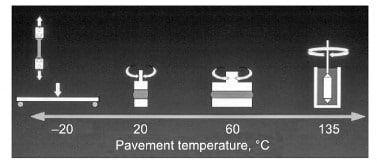
Superiorities of Bitumen Performance Grade (PG)
- Empirical methods such as viscosity and penetration grading systems were developed based on old experiences and can be applicable if those conditions still exist. But, climatic and current traffic conditions are rapidly changing and past experiences can no longer be defining criteria. In the PG system, it is possible to use actual traffic volume and vehicle speed which represents the duration of loads are applied.
- Common tests are conducted at a single test temperature which is 25 C in penetration and d 60 C in viscosity test, which means that they can not give any details about how the bitumen would behave in low or high temperatures. Superpave grading indicates a working temperature range of binder and therefore, helps with choosing the best type according to the condition each project demands.
- Because of the visco-elastic properties of bitumen, the rate of load application and temperature have a great effect on its behavior.
- Although the behavior of bitumen in lower loading rates corresponds to that of higher temperatures, none of the other grading systems doesn’t take the rate of load into account except for Superpave.
- While Superpave can be easily used for both unmodified and modified bitumen, conventional methods are used only for unmodified bitumen types,
- Conventional methods ignore the long-term aging of binders and its behavior. But Superpave takes both long-term aging -using with the pressure aging vessel (PAV)- and short-term aging -using the rolling thin film oven test (RTFOT)- into account.
- Bitumen properties indicated at different temperatures contribute to resistance to the distresses in a different level. Bitumen contributing in a better rutting resistance is measured at maximum pavement temperatures and which leads to a more elastic and stiffer binder. Bitumen contributing to fatigue resistance is the most crucial at average pavement temperatures and it requires a softer bitumen while it still favors an elastic binder. Bitumen contribution to thermal cracking is sensitive at minimum pavement temperatures and it demands a less elastic and soft bitumen.
Superpave PG Bitumen Nomenclature
Performance Grade (PG) Bitumen is categorized based on traffic and pavement temperature. the first being the average seven-day maximum pavement temperature (°C) and the second being the minimum pavement design temperature likely to be experienced (°C). Modification and monitoring done here, are meant to simulate conditions and traffic volumes to enable us to lengthen the life span of the pavement and enhance the quality. The PG grading system is defined by two numbers, representing the pavement temperatures. The first number (ex: PG 64-XX) represents the highest pavement temperature in Celsius, while the second number (ex: PG XX-22) represents the lowest. Thus, for example, PG 58-22 is intended for use where the average seven-day maximum pavement temperature is 58°C and the expected minimum pavement temperature is -22°C. Note that these numbers are pavement temperatures, not the air temperatures (these pavement temperatures are derived from air temperatures using an algorithm included in the LTPP Bind program). The high temperature is related to the effects of rutting and the low temperature relates to cold results such as fatigue cracking.
As a general rule-of-thumb, PG binders that differ in the high and low-temperature specification by 90°C or more generally require some sort of modification (Figure 1).
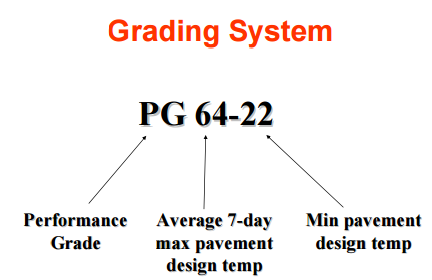
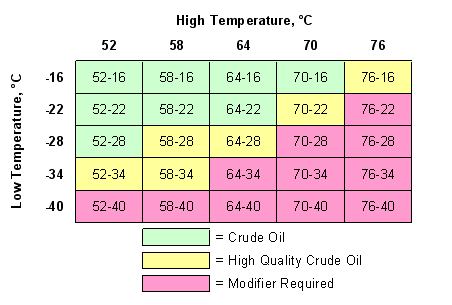
Application of PG Bitumen
PG52-28 is dominantly used in paving for both new construction and road care and also in both dense-graded and open-graded Hot Mix Asphalt (HMA). This product could also be used for sealing cracks in paving and also the edges. Other applications include spraying in places like bridge deck and pavement protective membrane with fabrics.
PG58-22 is initially used in paving for both dense-graded and open-graded Hot Mix Asphalt (HMA) and also in road construction usages as well as spraying and crack sealing applications.
PG58-28 is initially used in paving for both dense-graded and open-graded Hot Mix Asphalt (HMA) and also in road construction usages as well as spraying and crack sealing applications. This grade is widely used in very cold areas.
PG58-34 is generally used in the higher elevation roadways. This grade is a paving asphalt cement dominantly used for the production of Hot Mix Asphalt (HMA). It could also be used for sealing the edges of new to old paving and cracks sealing.
PG58-40 is primarily used on the high elevation locations. This grade is paving asphalt for the production of Hot Mix Asphalt (HMA). It can be easily used for sealing purposes and crack treating as well.
PG64-22 is mostly used in paving for both new construction and pavement treatment projects and in both dense-graded and open-graded Hot Mix Asphalt (HMA) as well as others. It can be easily used for sealing purposes and crack treating too. Other uses include spray applications for bridge decks and pavement protective layer with fabrics and some modifications. It has been reported that with proper aggregate selections and asphalt content, HMA with PG64-22 as the binder may show less tenderness compared to a similar mixture with a lower viscosity/softer asphalt. This will lead to a significant reduction of typical tenderness problems of mixture shoving and checking during pavement surface scuffing and rolling and markings caused by traffic immediately after paving.
PG64-28 is primarily used in road construction and paving for new and pave care projects and in both dense-graded and open-graded HMA. Other uses include spray applications for bridge deck and pavement protective layer with fabrics. PG64-28 is generally used for the locations with low elevation.
PG70-22 is primarily used in areas with high traffic volume and is also the paving asphalt cement used for the production of Hot Mix Asphalt (HMA). This grade is also a good choice for sealing the edges of pavement and for crack sealing.
PG Grades with the best resistance in thermal cracking
- PG 64 -22
- PG 76 -22
- PG 64 -28
- PG 58 -34
PG Grades with the best resistance against rutting
- PG 82 -22
- PG 76 -28
- PG 70 -28
- PG 76 -22
Common in toll roads (high Volume)
- PG 64-22
Common in toll booth (high volume and slow traffic)
- PG 70-22
Common in the rest area (high volume and standing traffic
- PG 76-22
Specification of Performance Grade Bitumen
• The table in Figure 2 is the standard summary table presented in the AASHTO MP 1 specification for performance graded asphalt binder. The following items may help to decipher this table:
• The top several rows (all the rows above the “original binder” row) are used to designate the desired PG grade. For instance, if the average 7-day maximum pavement design temperature is greater than 52˚C but less than 58˚C then you should use the “< 58” column. The temperatures directly under the “< 58” cell are selected based on the minimum pavement design temperature in ˚C.
• No matter what the desired PG binder specification, the same tests are run. The PG specification (e.g., PG 58-22) just determines the temperature at which the tests are run.
• Tests are run on the original binder (no simulated aging), RTFO residue (simulated short-term aging), and PAV residue (simulated long-term aging) in order to fully characterize the asphalt binder throughout its life. Notice that often the same test is run on different simulated binder ages. For instance, the dynamic shear test is run on all three simulated binder ages.
• The tests run on the binder are listed in the left-hand column. They are not necessarily listed by their common names but the applicable AASHTO test procedure is listed. For instance, “Flash Point Temp. T 48, Minimum (˚C)” means that the flashpoint is measured according to AASHTO T 48 and that the value in the adjacent column represents the minimum allowable in degrees Centigrade.
